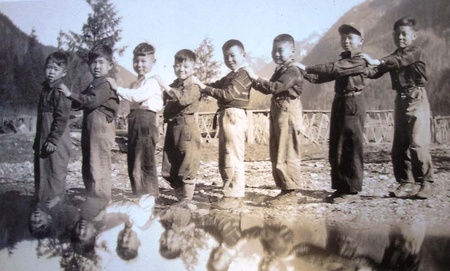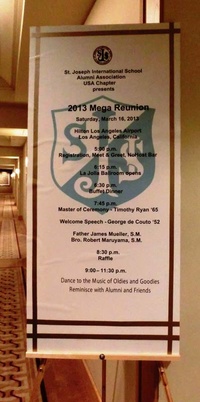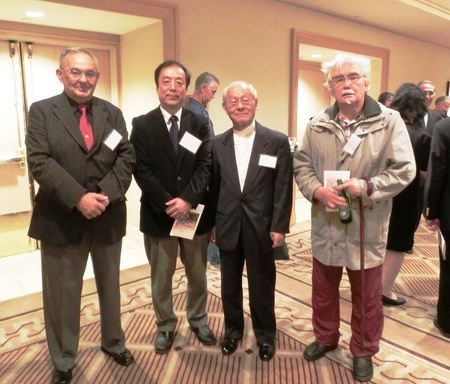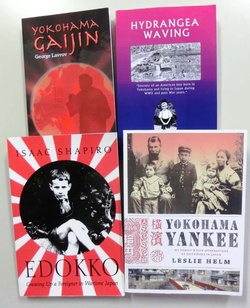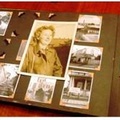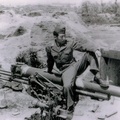Since the Meiji period, Yokohama Yamate has been home to a number of international schools. These include St. Maur (founded in 1872, Yamate 83), said to be the oldest in Japan, Yokohama International (YIS, 1924, Yamate 258), and St. Joseph's College (SJC, later SJIS, 1901, Yamate 43), which sadly closed in 2000.
Although there were some Japanese children enrolled in these schools, the majority were foreign children who lived in Yokohama or Tokyo. The school life of students, who came from families of various nationalities and forbidden to use Japanese, was extremely international, and after graduation, students went on to have careers all over the world. The family histories of people who attended international schools in Yokohama represent a typical aspect of the international port city of Yokohama.
From a certain encounter
Late last February, I was walking with some friends in Carmel, Northern California, on a sightseeing trip. As we were trying to find our way at an intersection, spreading out a map, a kind elderly American couple spoke to us. When we told them we were from Yokohama, they replied, "I've lived at 60 Yamate for 40 years." Donald Baumann graduated from SJC in 1952, and both his father and son attended the school, so it was a three-generation connection.
This chance encounter took me on a journey through the world history of "foreigners" who grew up in Yokohama.
We only had a brief chat, but when I mentioned that I was researching the history of international exchange in Yokohama, Bauman introduced me to Ken Suzuki, who lives near Los Angeles.
Ken was born in Vancouver in 1934 as the second generation of Canadian immigrants from Yokohama. During the war, he and his family were sent to a Japanese internment camp deep in the mountains, and in 1946 he returned to Isogo from Seattle. As he could speak English, he lived in the Chinatown Yokarou (now the site of Yokohama Daisekai), which was a hotel for the US military at the time, as a night manager, and paid his way to SJC on his own (graduating in 1953). Actor Masumi Okada's younger brother was in the same class as Ken, and apparently often came to their home in Isogo.
Ken was the secretary for SJC's overseas alumni association, and through him I was able to quickly get in touch with graduates living in the United States.
One of them is Tom Haar, who lives in Hawaii and graduated in 1960. His father is the Hungarian photographer Francis Haar, and he himself became a professional photographer in the same field. We spoke with Haar in Yokohama in September, when he came to Japan to hold a solo exhibition.
In 1937, his parents moved from Budapest to Paris, where they became acquainted with cultural figures who were in Paris at the time, including Junzo Sakakura, Tsuguharu Foujita, Ikuma Arishima, and Hiroshi Kawazoe. As a result of these connections, they came to Japan in 1939, and Tom was born in Tokyo. During the war, Tom was forcibly evacuated to Karuizawa, and after the war he attended SJC from Kamakura. He told us the story of his father and son, who came from Hungary, including their decision to move to Hawaii after their home country became a communist state.
American Alumni Association
Ken and Tom told me that a joint reunion for graduates of Yokohama International Schools would be held in Los Angeles this spring, and I was honored to accept the invitation. This was a fantastic opportunity to cover the history of international exchange in Yokohama.
A few days before the event, Ken was patiently waiting for me when I arrived at Los Angeles Airport three hours late.
The passenger in Ken's car was Zoofa Majid (SJC 1955 graduate), who came from San Francisco that day. Majid, who is of Turkish descent, commuted to Yokohama from Yoyogi-Uehara, where there is a mosque nearby. After graduating, he served in the Turkish Navy for a time and then worked for JAL for many years. Although he looks foreign, he speaks Japanese with a mix of puns and loves enka and karaoke. He immediately showed me some old photos he had brought with him.
On March 16th, about 120 people gathered at a hotel near the airport, including 58 from SJC, 14 from Saint-Maur, and 6 from YIS. The reunion began with an address by the oldest alumni, George de Koot (Class of 1952 from SJC). Aside from the fact that the participants were "foreigners" and the language spoken was a mix of English and Japanese, people were catching up on old memories at tables here and there, just like in Japan.
In addition to this general meeting, several class meetings were held, and I was able to attend those and hear from a variety of people. I would like to introduce some of them.
Willy da Silva graduated in 1955. His great-grandfather came to Yokohama from Portugal as a navigator in the 1860s, soon after the port was opened. Since then, many members of the family have lived in Yokohama and are well known in the city's foreign community.
Ms. Minette Yoshimoto Wilkinson from New York graduated from Sun Mall in 1955. Her grandfather was Mitsuzo Yoshimoto, the founder of the Navy Band, her father worked for a trading company, and her mother is French. After the outbreak of war between Japan and the United States, her parents returned to Japan from New York on an exchange ship.
Luke Schneider, who graduated from SJC in 1954, had a German grandfather who introduced the art of shell buttons to Kobe in the 1880s, and his grandmother was from Tochigi Prefecture. Luke's mother was a Christian and attended Soshin Girls' School. In 1940 they moved to Myorenji, Yokohama, but during the war, while he was left in Kobe, he was caught talking to his older brother in English on a train by the military police and beaten. His brother died as a result, and Luke Schneider himself suffered severe hearing problems. This is why he still has a loud voice. After studying hard, he worked in undersea resource surveys. He currently lives in Myorenji.
Jeong Yong-kuk, from Warrenton, Oregon, graduated in the same class as Ken in 1953. He experienced the Great Tokyo Air Raid while attending Fukagawa Elementary School in Tokyo. As a Korean living in wartime Japan, he must have faced many hardships, but he named Kunio Hotta as one of his respected elementary school teachers. He attended SJC to study English, and after graduating he went to America, studied at several universities, and opened an orthodontic clinic. During the Korean War, he was posted to Busan as a military dental surgeon.
Jimmy Walker, who lives in Fountain Valley, graduated in 1957 and is an actor with the Japanese name Okawa Osamu. He has appeared in many films and TV dramas that the author also watched as a child. He often plays villains and other characters with strong personalities, but he is also memorable for his friendly smile. He talked about his own roots, which began with his ancestors who came to Japan from England, and his memories of great stars of the past such as Katsu Shintaro and Hasegawa Kazuo.
The World of "Yokohama Foreigners"
In recent years, there has been a succession of publications of autobiographies and family histories by foreigners who have lived in Yokohama.
Georgi Lavrov's "Yokohama Gaijin" is the story of a White Russian family whose parents, born in Imperial Russia, fled the chaos of the revolution, passing through Harbin, Shanghai, and Korea before arriving in Japan in the late 1920s. The author was born in Yokohama and graduated from SJC in 1959. He lost his older brother in the May 1945 air raids.
Joe Hall's book "Hydrangea Waving" has the subtitle "The journey of a boy born in Yokohama who lived in Japan during and after the war", and describes Yokohama as "a cosmopolitan city with an influx of foreigners from Asia, Europe and the US". The author is a 1956 graduate of SJC. After serving in the military in the Philippines, his father came to Yokohama from New York to do business with a confectionery company in Tsurumi. It was here that he married his mother, who was born to a British father and a Japanese mother. His father died early, and he lived with his mother, who remarried a Thai embassy employee. His maternal grandmother lived in Rokkakubashi, and he often visited the area.
Another book by Isaac Shapiro, "EDOKKO," is a magnificent family history of a wealthy Russian Jewish family that spread across the world. The parents were well-known musicians active in the West, and lived in Sagiyama, Yokohama, and then Honmoku from 1936. The author's four siblings attended YIS and SJC, and later scattered across the United States, the Soviet Union, Israel, and Japan. The author also served as the head of the New York branch of the Japan Society. This book, which richly depicts the foreign community in Yokohama during and after the war, would be better titled "Hamakko."
Recently, Leslie Helm's "Yokohama Yankee" was published. The author is a YIS graduate and journalist living in Seattle. It tells the story of five generations, beginning with his great-grandfather, who traveled from Prussia to America in 1868, but ended up in Yokohama after taking a wrong turn. "Helm & Co. of Yamashitacho" is a famous businessman in Yokohama, and the book is a joy to look at, sprinkled with original photographs (including one of Seigo Takamori!?) and colored postcards of Yokohama.
We can learn a lot about world history from the stories of "Yokohama Gaijin" and "Yokohama Yankee" who graduated from Yamate International School. Seeing Yokohama from the eyes of "foreigners" in this way may be especially necessary for us who live in the globalized world.
*Reprinted from Quarterly Yokohama, No. 41 (July 2013, Yokohama City Citizens Affairs Bureau Public Relations Division/Published by Kanagawa Shimbun).
© 2013 Hiroshi Onishi


